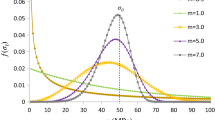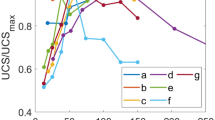Abstract
The determination of the size of the representative elementary volume (REV) is important to measure or predict mechanical and physical effective properties of heterogeneous materials. This paper presents a numerical procedure to determine the REV size of intact rocks using a polygonal grain-based model. A large number of rock models with side lengths varying from 10 to 80 mm were generated in a square region based on the growing window technology. These models were then employed to carry out numerical compressive tests to determine the macroscopic mechanical properties of rocks for REV determination. Variations in the mineral volume fraction, compressive strength, elastic modulus, and Poisson’s ratio with the sample size were investigated. The coefficient of variation (\(\varepsilon\)) was introduced to denote the fluctuation of the properties. The REV sizes were determined by defining an acceptable value of \(\varepsilon\). As the sample size increased, the coefficients of variation of the properties decreased. The REV sizes varied for different investigated properties; among them, the REV size for compressive strength was largest. To achieve mechanical representation of the overall rocks, the REV size should be at least 20 times the largest mineral grain size in the specimen, which was verified in the simulations. Geometric heterogeneity and mineral volume fractions also influenced the REV size. The simulated results indicate that the REV size for compressive strength had a positive dependence on the heterogeneity index, while it slightly decreased with the increase in volume fraction of biotite from 10.4 to 60.4%.

















Similar content being viewed by others
Data availability
The datasets generated during and/or analyzed during the current study are available from the corresponding author on reasonable request.
Abbreviations
- \(\Delta \sigma_{n}^{{}}\) :
-
Effective contact stress increment (Pa)
- \(\Delta U_{n}^{{}}\) :
-
Normal displacement increment (m)
- \(\Delta U_{s}^{e}\) :
-
Elastic component of the shear displacement (m)
- \(k_{{\text{n}}}\) :
-
Normal stiffness of the contact (GPa/m)
- \(k_{{\text{s}}}\) :
-
Shear stiffness of the contact (GPa/m)
- \(T_{m}\) :
-
Tensile strength for contact (MPa)
- \(\tau_{{\text{s}}}\) :
-
Shear strength for contact (MPa)
- \(c\) :
-
Cohesive strength (MPa)
- \(\phi\) :
-
Friction coefficient
- \(\sigma_{{\text{c}}}\) :
-
Compressive strength of rock (MPa)
- \(\sigma_{{\text{t}}}\) :
-
Tensile strength of rock (MPa)
- \(\varepsilon\) :
-
Coefficient of variation
- \(H\) :
-
Heterogeneity index
- \(\varphi\) :
-
Ratio of sample size to the maximum diameter of the grains (mm)
- \(\varepsilon_{{\text{r}}}^{{}}\) :
-
Acceptable relative error for estimation
- \(D_{Z}^{2} (V)\) :
-
Variance of its average value
References
Akhondzadeh H, Keshavarz A, Al-Yaseri AZ et al (2020) Pore-scale analysis of coal cleat network evolution through liquid nitrogen treatment: a micro-computed tomography investigation. Int J Coal Geol 219:103370
Bachmat Y, Bear J (1987) On the concept and size of a representative elementary volume (Rev). Advances in Transport Phenomena in Porous Media. Springer, Dordrecht, pp 3–20
Bandara KMS, Ranjith PG, Kumari WGP (2021) A coupled x-ray imaging and experimental permeability study of propped hydraulically induced fractures. Rock Mech Rock Eng 58:2581–2596
Blair SC, Cook NGW (1998) Analysis of compressive fracture in rock using statistical techniques: part II. Effect of microscale heterogeneity on macroscopic deformation. Int J Rock Mech Min Sci 35:849–861
Bouchedjra M, Kanit T, Boulemia C et al (2018) Determination of the RVE size for polycrystal metals to predict monotonic and cyclic elastoplastic behavior: Statistical and numerical approach with new criteria. Eur J Mech A Solids 72:1–15
Cundall P (1980) UDEC—a generalised distinct element program for modelling jointed rock. Peter Cundall Associates Report, European Research Office, US Army, Contract, DAJA37-79-C-0548. In: Peter Cundall associates report, p 74
Cundall PA, Hart RD (1992) Numerical modelling of discontinua. Eng Comput 9:101–113
Deng L-C, Li X-Z, Wang Y-C et al (2021) Effect of temperature on macroscopic and microscopic properties of sandstone from Qidong coal mine. Rock Mech Rock Eng 55:75–90
Fairhurst JaH CE (1999) International society for rock mechanics commission on testing methods. Int J Rock Mech Min Sci 36:279–289
Fan M, Chen Y, Wan K (2021) Representative elementary volume analysis of hardened cement paste during hydration using X-ray computed tomography. Constr Build Mater 277:122268
Fernandes J, Appoloni C, Fernandes C (2012) Determination of the representative elementary volume for the study of sandstones and siltstones by X-ray microtomography. Mater Res 15:662–670
Ghazvinian E, Diederichs MS, Quey R (2014) 3D random Voronoi grain-based models for simulation of brittle rock damage and fabric-guided micro-fracturing. J Rock Mech Geotech Eng 6:506–521
Gitman IM, Askes H, Sluys LJ (2007) Representative volume: existence and size determination. Eng Fract Mech 74:2518–2534
Harris WM, Chiu WKS (2015) Determining the representative volume element size for three-dimensional microstructural material characterization. Part 1: predictive models. J Power Sources 282:552–561
He X, Xu C (2015) Discrete element modelling of rock cutting: from ductile to brittle transition. Int J Numer Anal Meth Geomech 39:1331–1351
Kanit T, Forest S, Galliet I et al (2003) Determination of the size of the representative volume element for random composites: statistical and numerical approach. Int J Solids Struct 40:3647–3679
Khdir YK, Kanit T, Zaïri F et al (2013) Computational homogenization of elastic–plastic composites. Int J Solids Struct 50:2829–2835
Koyama T, Jing L (2007) Effects of model scale and particle size on micro-mechanical properties and failure processes of rocks—a particle mechanics approach. Eng Anal Bound Elem 31:458–472
Li Z, He X, Teng Q et al (2021) Reconstruction of 3D greyscale image for reservoir rock from a single image based on pattern dictionary. J Microsc 283:202–218
Liu G, Cai M, Huang M (2018) Mechanical properties of brittle rock governed by micro-geometric heterogeneity. Comput Geotech 104:358–372
Liu S, Huang Z (2021) Analysis of strength property and pore characteristics of Taihang limestone using X-ray computed tomography at high temperatures. Sci Rep 11:13478
Liu Y, Wang Q, Chen J et al (2021) Investigation of geometrical representative elementary volumes based on sampling directions and fracture sets. Bull Eng Geol Env 80:2171–2187
Loyola AC, Pereira J-M, Cordão Neto MP (2021) General statistics-based methodology for the determination of the geometrical and mechanical representative elementary volumes of fractured media. Rock Mech Rock Eng 54:1841–1861
Łydżba D, Różański A (2014) Microstructure measures and the minimum size of a representative volume element: 2D numerical study. Acta Geophys 62:1060–1086
Ma W, Chen H, Zhang W et al (2021) Study on representative volume elements considering inhomogeneity and anisotropy of rock masses characterised by non-persistent fractures. Rock Mech Rock Eng 54:4617–4637
Mahboubi Niazmandi M, Binesh SM (2020) A DFN–DEM approach to study the influence of confinement on the rev size of fractured rock masses. Iran J Sci Technol Trans Civ Eng 44:587–601
Min K-B, Jing L, Stephansson O (2004) Determining the equivalent permeability tensor for fractured rock masses using a stochastic REV approach: method and application to the field data from Sellafield, UK. Hydrogeol J 12:497–510
El Moumen A, Kanit T, Imad A et al (2015) Effect of reinforcement shape on physical properties and representative volume element of particles-reinforced composites: Statistical and numerical approaches. Mech Mater 83:1–16
El Moumen A, Kanit T, Imad A (2021) Numerical evaluation of the representative volume element for random composites. Eur J Mech A Solids 86:104181
Ni P, Wang S, Wang C et al (2017) Estimation of REV size for fractured rock mass based on damage coefficient. Rock Mech Rock Eng 50:555–570
Peng H, Fan J, Zhang X et al (2020) Computed tomography analysis on cyclic fatigue and damage properties of rock salt under gas pressure. Int J Fatigue 134:105523
Peng J, Wong LNY, Teh CI (2017) Influence of grain size heterogeneity on strength and microcracking behavior of crystalline rocks. J Geophys Res Solid Earth 122:1054–1073
Ren ZY, Zheng QS (2002) A Quantitative study of minimum sizes of representative volume elements of cubic polycrystals—numerical experiments. J Mech Phys Solids 50:881–893
Ren ZY, Zheng QS (2004) Effects of grain sizes, shapes, and distribution on minimum sizes of representative volume elements of cubic polycrystals. Mech Mater 36:1217–1229
Romero P, Masad E (2001) Relationship between the representative volume element and mechanical properties of asphalt concrete. J Mater Civ Eng 13:77–84
Savvas D, Stefanou G, Papadrakakis M (2016) Determination of RVE size for random composites with local volume fraction variation. Comput Methods Appl Mech Eng 305:340–358
Stroeven M, Askes H, Sluys LJ (2004) Numerical determination of representative volumes for granular materials. Comput Methods Appl Mech Eng 193:3221–3238
Wang Z, Li W, Bi L et al (2018) Estimation of the REV size and equivalent permeability coefficient of fractured rock masses with an emphasis on comparing the radial and unidirectional flow configurations. Rock Mech Rock Eng 51:1457–1471
Wang Z, Wang T, Wu S et al (2021) Investigation into the effects of grain size on strength and failure behaviors of granites using a breakable polygonal grain–based model. Bull Eng Geol Env 80:6989–7007
Wang Z, Wang T, Wu S et al (2021) Investigation of microcracking behaviors in brittle rock using polygonal grain-based distinct method. Int J Numer Anal Meth Geomech 45:1871–1899
Wang Y, Xiao Y, Hou Z et al (2020) In situ X-ray computed tomography (CT) investigation of crack damage evolution for cemented paste backfill with marble waste block admixture under uniaxial deformation. Arab J Geosci 13:1018
Xia L, Zheng Y, Yu Q (2016) Estimation of the REV size for blockiness of fractured rock masses. Comput Geotech 76:83–92
Xiao N, Zhou X, Berto F (2021) Fracture analysis of rock reconstruction models based on cooling–solidification annealing algorithms. Fatigue Fract Eng Mater Struct 44:2503–2523
Xu J, Haque A, Gong W et al (2020) Experimental study on the bearing mechanisms of rock-socketed piles in soft rock based on micro X-ray CT analysis. Rock Mech Rock Eng 53:3395–3416
Yang S, Dirrenberger J, Monteiro E et al (2019) Representative volume element size determination for viscoplastic properties in polycrystalline materials. Int J Solids Struct 158:210–219
Yin T, Chen Q (2020) Simulation-based investigation on the accuracy of discrete fracture network (DFN) representation. Comput Geotech 121:103487
Zhou W, Cheng J, Zhang G et al (2021) Effects of wetting-drying cycles on the breakage characteristics of slate rock grains. Rock Mech Rock Eng 54:6323–6337
Zhou X-P, Jiang D-C, Zhao Z (2021) Digital evaluation of micro-pore water effects on mechanical and damage characteristics of sandstone subjected to uniaxial, cyclic loading-unloading compression by 3D reconstruction technique. Rock Mech Rock Eng 55:147–167
Funding
This work was supported by the Natural Science Foundation of Shaanxi Province in China (2022JQ-349, 2022JQ-333) and China Scholarship Council (202008615032).
Author information
Authors and Affiliations
Corresponding authors
Ethics declarations
Conflict of interest
Authors are required to disclose financial or non-financial interests that are directly or indirectly related to the work submitted for publication.
Additional information
Publisher's Note
Springer Nature remains neutral with regard to jurisdictional claims in published maps and institutional affiliations.
Rights and permissions
Springer Nature or its licensor holds exclusive rights to this article under a publishing agreement with the author(s) or other rightsholder(s); author self-archiving of the accepted manuscript version of this article is solely governed by the terms of such publishing agreement and applicable law.
About this article
Cite this article
Wang, Z., Wang, T., Wang, W. et al. Size of representative elementary volume for heterogeneous rocks evaluated using distinct element method. Acta Geotech. 18, 1883–1900 (2023). https://doi.org/10.1007/s11440-022-01663-w
Received:
Accepted:
Published:
Issue Date:
DOI: https://doi.org/10.1007/s11440-022-01663-w




